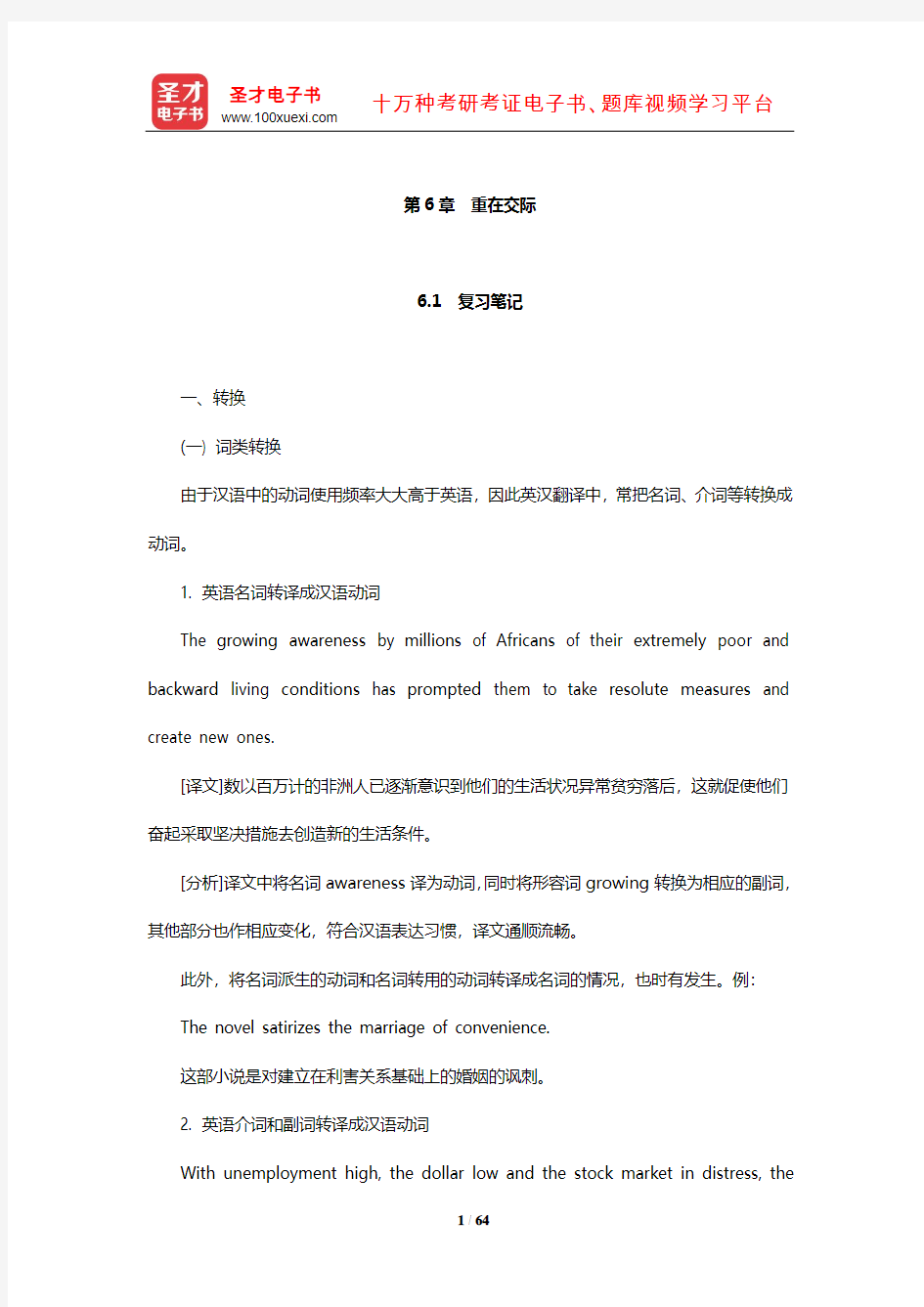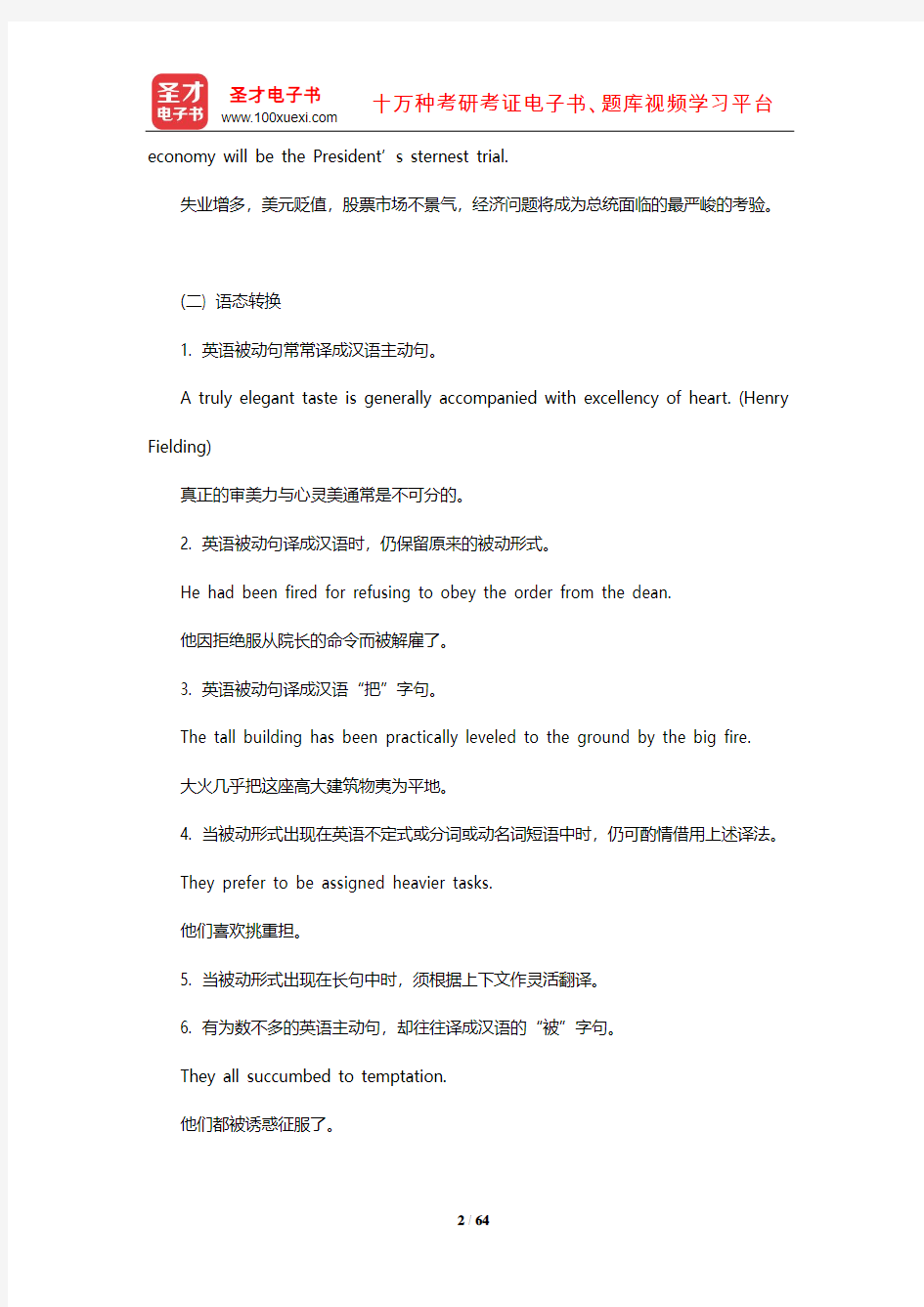王治奎《大学英汉翻译教程》【笔记课后习题及翻译示例汇总考研真题详解】(重在交际)


第6章重在交际
6.1 复习笔记
一、转换
(一) 词类转换
由于汉语中的动词使用频率大大高于英语,因此英汉翻译中,常把名词、介词等转换成动词。
1. 英语名词转译成汉语动词
The growing awareness by millions of Africans of their extremely poor and backward living conditions has prompted them to take resolute measures and create new ones.
[译文]数以百万计的非洲人已逐渐意识到他们的生活状况异常贫穷落后,这就促使他们奋起采取坚决措施去创造新的生活条件。
[分析]译文中将名词awareness译为动词,同时将形容词growing转换为相应的副词,其他部分也作相应变化,符合汉语表达习惯,译文通顺流畅。
此外,将名词派生的动词和名词转用的动词转译成名词的情况,也时有发生。例:
The novel satirizes the marriage of convenience.
这部小说是对建立在利害关系基础上的婚姻的讽刺。
2. 英语介词和副词转译成汉语动词
With unemployment high, the dollar low and the stock market in distress, the
economy will be the President’s sternest trial.
失业增多,美元贬值,股票市场不景气,经济问题将成为总统面临的最严峻的考验。
(二) 语态转换
1. 英语被动句常常译成汉语主动句。
A truly elegant taste is generally accompanied with excellency of heart. (Henry Fielding)
真正的审美力与心灵美通常是不可分的。
2. 英语被动句译成汉语时,仍保留原来的被动形式。
He had been fired for refusing to obey the order from the dean.
他因拒绝服从院长的命令而被解雇了。
3. 英语被动句译成汉语“把”字句。
The tall building has been practically leveled to the ground by the big fire.
大火几乎把这座高大建筑物夷为平地。
4. 当被动形式出现在英语不定式或分词或动名词短语中时,仍可酌情借用上述译法。
They prefer to be assigned heavier tasks.
他们喜欢挑重担。
5. 当被动形式出现在长句中时,须根据上下文作灵活翻译。
6. 有为数不多的英语主动句,却往往译成汉语的“被”字句。
They all succumbed to temptation.
他们都被诱惑征服了。
(三) 正反转换
采用正说反译和反说正译的转换法目的有三:(1) 保证语义明确;(2) 加强修辞效果;
(3) 尊重汉语表达习惯,使译文通顺易懂。
1. 保证语义明确
(1) 正说反译
Her conduct is above reproach.
她的行为无可指责。
(2) 反说正译
I won’t keep you waiting long.
我一会儿就回来。
2. 加强修辞效果
(1) 正说反译
That’s a thing that might ha ppen to anyone.
这种事情谁也难免。
(2) 反说正译
Isn’t it funny?
真逗!
3. 尊重汉语表达习惯,保证译文通顺易懂
(1) 正说反译
Mary lay awake almost the whole night.
玛丽躺在那儿,几乎一夜没合眼。
(2) 反说正译
We never know the worth of water till the well is dry.
井枯方知水可贵。
二、变通:增减词语
“变通”可包括:增加必要的词语,省略不必要的词语,重新考虑原来的句法功能,改变原来的句式。
(一) 增词
1. 语义性增词
翻译中常根据意义上的需要增词,以及表示名词复数、动词时态等方面的词。例:They wanted a generation of Americans conditioned to loyalty and duty.
他们都希望把下一代美国人训练得忠于祖国,恪尽职责。
2. 结构性增词
按句法需要补译英文中省略的各种成分称作结构性增词。例:
This is as true of nations as it is of individuals.
个人是这样,国家也是这样。(…as it is true of individuals.)
3. 修辞性增词
修辞性增词往往是不改变原文词句意思的语气补足词、强调性副词或其他修辞上所需要的词汇。而且,重复一些关键性的词,也被视为修辞性增词。例:
For all sad words of tongue or pen, the saddest are there: “It might have been!”
口头说的也好,笔头写的也好,最糟糕的莫过于:“或许本来就是!”
(二) 省略
1. 句法性省略
(1) 省略代词
◆省略人称代词
作主语的人称代词和作宾语的人称代词汉译时往往省略。例:
Give him an inch and he’ll take an ell.
得寸进尺。
◆省略物主代词
To widen your life without deepening it is only to weaken it.
拓宽而不加深生活,只能削弱生活。
◆省略非人称代词it
用来表示时间、天气、自然环境或距离的非人称代词it, 用来代替不定式短语或从句作形式主语的先行代词it, 以及强调式中的it, 汉译时往往省略。例:
It was a bitterly cold night and at ten o’clock it began to blow a gale.
那是一个寒冷刺骨的夜晚,10点钟时,大风骤起。
(2) 省略连词
◆并列连词and和or等有时可以不译出。例:
Wise men love truth, whereas fools shun it.
智者热爱真理,愚者逃避真理。
◆省略从属连词。汉译时,英语中表示原因、条件或时间的从属连词有时可以省略。例:
If a country has an abundance of natural resources, it is common for it to export some of them.
一个国家的自然资源十分丰富,出口一些资源是不足为奇的。
(3) 省略冠词
一般说来,除了带有明显指示意义的定冠词和含有明显的“一个”或“每一个”意思的不定冠词不能不译外,其他情况一般可以省略不译。
(4) 省略介词
一般说来,如果译文中将表示时间或地点的介词短语所充当的状语置于句首,此时介词往往可以省略。
2. 修辞性省略
(1) 省略不言而喻的词
These uses are based on the fact that silicon is semi—conductor of electricity.
这些用途乃基于硅是半导体。
(2) 省略重复的名词
英语中,有些同义词往往连用,或表示强调,或对前面的词提供意思上的解释;汉译时,为了避免重复,译出其中的一个即可。
Our commander guarded it (the newspaper) like the apple of his eye.
我们的司令员护着那张报纸,正跟护着他的眼珠子一样。
(3) 省略为了语气关系而多加的副词或连词,如:so, then, and then等。
She came to the dining-room window and then cautiously looked in.
她来到餐厅窗前,小心翼翼地向里观看。
三、变通:改变句式
(一) 关系从句
十二天突破英汉翻译笔记
一天突破英文中定语从句的翻译(一) 4 英文中的介词可以翻成中文里的方位副词的动词 There is a book on the desk. 桌上有本书。 The teacher came into the classroom with a book and a dog.老师带着一本书和一只狗…… 6 一般8个单词以下定语从句前置,多于8个单词后置。定语从句翻译后置方法中,需要译出关系词。 63 非限制性定语从句需要后置译法,且翻译关系词。 7 循环套用1: 中心词+定语1+定语1的定语2+定语2的定语3+…… 翻译方法看长度: 定语1+2=3 前两者放在一起翻译 定语1=2+3 后两者放在一起翻译 14 循环套用2: 中心词+定语1+定语1的定语2 翻译时:2+1+含有中心词的句子 注: 10 which有时指前面整个句子; 14 有时定语从句远离先行词; where“在那里” 11 prior to(主张多用)=before 11 “其”是中文专门用来表示第三人称的词。 13 定语从句一般不可放在句首 13 被动语态:用“为”代替“被” 英汉差异: 13 英文中多用代词;中文多用名词,不怕重复 15 英文多用长句,不注重标定符号的使用;中文多用断句且多用标点 23 英文多用名词;中文多用动词(动词的过渡) 英译汉: 9 适时断句,避免长句 12 重要的句子在后面翻译,不重要的先翻译 15 适时增加表示逻辑关系的词,使句子更具逻辑性 第二天突破英文中定语从句的翻译(二) 18 并列套用:多个并列定语修饰一个中心词 后置译法,关系词只需译一次 18 本位词&外位词
本位词:这,这样,这些 外位词:被本位词所替代的部分 一般用定语从句的which/of来翻译本位词 ...women in novels were stereotype of lacking any features... 小说中的妇女都是这样一种模式,她们缺少…… This assumption rests on the fallacy of the ... 假设是基于这样一种谬论:…… 19 There are not a few of people. 有不少人。 There are very few people who would not like to do it. 没有多少人愿意做这件事情。 20 abnormally 不正常地;病态地;特别,尤其 21 短句翻译:剥洋葱 先次后主,有逗号 21 中文:事实+评论 英文:评论+事实 22 It is often said that...人们常说 it is believed that...人们相信 It is guessed that...人们猜测 It is thought that...人们认为 It is supposed that...人们推测 It is reported that...据报道 插入语 23 表示观点时,提到句首翻译 27 不表示观点时,保留在原来位置,用破折号连接 23 谓语动词的过渡 英译汉 keep one informed current events keep是过渡词,本身动词性很弱,它的存在是为了informed的存在,因此翻译时直接忽略keep翻译inform 汉译英 中文“副词+动词”——英文“副词变动词,动词变名词” 28 West Bejing人为划分的行政区域,西北京 Western Beijing自然地理意义上的范围,北京的西部 the West of Beijing不在北京范围内,北京的西边 29 一般英文的人名和地名都要求固定中文译法 White 怀特 Watt 瓦特 Walt 沃尔特
2017年北京外国语大学翻译硕士日语考研参考书目、历年真题、考研真题
2017年北京外国语大学翻译硕士专业日语考研必读信息 复习经验经验指导 1、抓住重点,快速复习 2、建立框架,系统复习 3、明确背诵,精确记忆 4、区分主次,结合热点 5、模拟训练,名师批阅 6、押题模考,一战封侯 北京外国语大学考研—日语口译文学资料 口承文学の時代から記載文学時代へ ずっと昔、日本の祖先は祭りを通して、共同体を結んでいった.その当時、文字がなくて、祭りの場で、神々や祖先に対して語られ歌われる神聖な言葉は、口々相伝得るより仕方がなく、長い間、子々孫々に言い継ぎ、歌い継いで、伝承されていった。このように誕生した神話、伝説、歌謡、祝詞などを口承文学と言う。 大和朝廷は国家を統一すると、朝鮮、中国との交流が盛んになった。4世紀ごろに、大陸から漢字が伝わってきた。そして、だんだん実用化され、6世紀ごろに、漢字で表記できるようになり、文学作品も漢字によって、記載されるようになった。これは記載文学の始まりである。 祝詞:古代人は言霊信仰によって、神への祈りの言葉を祝詞と言う。その中には、神事の時群臣に読み聞かせるものとか、祭りの儀式のときに神に祈願するものとか、天皇に上奏して御代の長久を
祈るものなどがある。現存するのは「延喜式」の27編、「台記」の別記に収められた「中臣寿詞」の一編を合わせて、計28編である。 宣命:宣命と言うのは、天皇の詔を臣下に伝える和文体の詞章である。漢文体を詔勅と言うが、純粋の和文体で書かれたのを「宣命書き」と言う。「続日本記」の62編は現存する宣命である。 一奈良時代 1.記紀文学――「古事記」と「日本書紀」 「古事記」 712年に、太安万侶によって編集されたと言うことである。上、中、下の3巻からなっている。日本語で書かれ、前代の伝説、民衆の生活も含み、そこから古代日本人の考え方や個人感情などを理解することができる。文学性がかなり高い。今まで保存している日本最古の書籍である。 「日本書紀」 720年に舎人親王などが編集したものである。これは漢文体で書いた30巻よりなる歴史書の形をしたものである。中国の史書にならって、漢文の編年体で書かれたものである。天皇の君主としての地位を正当化する目的で、全体の構想が創作されている。 「古事記」と「日本書紀」は日本文学史の中で、最初の整った本の形であろう。記紀文学は人民大衆の文学ではなく、国家最高権利者である天皇、貴族の文学である。しかし、その中から、当時の地方民衆の生活状況や宗教などがわかり、民俗研究の貴重な資料として、かなり大きな価値がある。また、「古事記」「日本書紀」には、“まこと”と言う文学意識が芽生えていた。しかし、それは個人或いは人民大衆の思想感情の表れではなく、大和民俗固有の信仰、即ち神への崇拝と言う原始的な信仰をもとに生まれたのである。言い換えれば、この文学意識は写実の文学意識の芽えともいえよう。 「風土記」 713年、朝廷が諸国に命じて、その国の地理、産物、伝説などを記させた。日本の最初の地誌であ
英汉翻译课堂笔记梳理及扩展
English—Chinese Translation and Extensive Knowledge 第一讲(四课时)翻译的历史起源以及各大著名理论和概论 2012/09/18 第一节:翻译起源以及翻译大家(一) 1.1翻译事业在我国有着悠久的历史。 最早的佛经翻译是西汉哀帝元寿元年(公元前2年)贵霜帝国大月氏王遣使者伊存来中国口授佛经,博士弟子秦景宪协助使伊存得以记录的《浮图经》。 中国历史上出现过三次翻译高潮:东汉至唐宋的佛经翻译、明末清初的科技翻译和鸦片战争至“五四”的西学翻译。佛经翻译是中国翻译事业的起点。中国的翻译活动可以追溯到春秋战国时代。中国真正称得上语际翻译的活动应该说是始于西汉的哀帝时期的佛经翻译。这一时期的佛经翻译活动还只是民间私人事业到了符秦时代,佛经翻译活动就组织有序了。当时主要的组织者是释道安。因此他主张严格的词对词、句对句(word for word, line for line)的直译。道安在此期间请来了著名的翻译家天竺(即印度)人鸠摩罗什。他翻译了三百多卷佛经文献,如《金刚经》、《法华经》、《十二门论》、《中观论》、《维摩经》等。其译文神情并茂、妙趣盎然,堪称当时的上乘之译作,至今仍被视为我国文学翻译的奠基石。 Representative:唐玄奘(西元600-664年)主要生活在初唐时期,一生共翻译了佛教大小乘经论75部1335卷,共计一千多万;玄奘的译著从数量和品质上都达到了中国佛经翻译史上的高峰;堪称:翻译家中的第一人;其成就主要在于是“新译”的创始人。他提出的著名的“五不翻”原则及“既须求真,又须喻俗”的标准,对我国翻译事业有很大影响。 ↓↓ (所谓“求真”就是指翻译必须忠实于原文内容并保持原文风貌;所谓“须喻俗”,就是指译文语言必须通顺易懂并符合其语言规范。玄奘将“须求真”和“须喻俗”有机地结合,使两者相辅相成,) (所谓“不翻”,不是不翻译,而是指“音译”。玄奘列举了5种应该音译的情况,即“五不翻”。其“五不翻”具体为:(1)秘密之,故不翻。佛经中有许多咒语,有其秘密的意思和作用,应该音译,如“陀罗尼”。(2)含多义,故不翻。即一词多义的梵文,在汉语中找不到合适的词汇来表达,因此保留原文,只作音译。如“薄伽梵”,在梵文里便有六层意思。(3)此方所无,故不翻。“此方”即“中国”,指在中国文化中没有的事物应该音译。如“阎浮”树,由于产于印度等地,而我国没有这种树,故保留原意。(4)顺于古例,故不翻。指有些约定俗成的词语应该遵循习惯采取音译。例如“阿耨多罗三藐三菩提”,本来意“指无上正等正觉”,但由于自东汉以来,历代译经家用“音译”翻译,因此保留前人翻译模式,不再翻译成“无上正等正觉”。(5)为生善,故不翻。指具有特殊意义或功能的词语也应当音译。如“般若”虽可意译为智慧,但却是佛教文化中蕴含着特殊意义的一种智慧,一旦把意思直接译出来,则会韵味尽失。“五不翻”原则对我国翻译事业影响极其巨大,直到现在,仍然具有深远的影响。) 1.2文学翻译阶段及其代表人物 文学翻译阶段大致在19世纪60年代到20世纪80年代
天搞定考研英语翻译考研翻译教学奇才云立宏全程笔记
法国有位化学家曾说过: 人如果不能把平生所学全部推翻,这个人就等于什么都没有学到; 《考研英语翻译高分新思维》,就是用最回归本质的方式,颠覆考生对于考研英语的传统错误理解,让考生能够像英语国家人一样自由的输入和输出英语。 本课程,提升的不仅仅是翻译。翻译前对于文章观点的快速把握能帮你打通阅读理解的文章关;理解英语国家人民是如何简单快速的输出英语能让你的写作流畅自如。 考研学生都会有这样一个问题: 需要考取多少分才能达到理想学校的要求? 换算到我们翻译部分应该得多少分呢? ◆想考211大学,英语一翻译需要5分以上,英语二翻译需要11以上; ◆想考985大学,英语一翻译需要6分以上,英语二翻译需要12分以上; ◆想考北大、复旦等一流大学,英语一翻译需要7分以上,英语二翻译需要13分以上。 而历年的英语一翻译平均成绩只有不到4分,英语二的平均分不到10分,也就是说,一大半的考生都要倒在翻译上。 有考生说翻译难:翻译不像阅读、完形,不会做你可以猜,时间不够可以蒙。 也有考生说翻译容易: (1)输出的是汉语; (2)要求不高:考研翻译要求(6个字)“准确、完整、通顺”;而不是“信、达、雅”。 为什么最容易提分的板块,得分情况却最不尽如人意?
因为大多数考生从来没有真正弄懂英语的语言规律, 学习英语的方法还是大学之前的老一套:整日重复做着繁琐又枯燥却毫无价值的语言结构分析。其实,只要方法科学有效, 所有考生都可以完全掌握好英语,甚至将英语变成自己的专长。所以,本期翻译课程,之所 以称为“高分新思维”,就是因为不会采取传统的讲授方法,没有死板的学术套路,不会为考 生列举机械的条条框框,不会寄希望考生课后大量艰苦的练习,结果考分还不尽如人意。 《考研英语翻译高分新思维》将直击制约考研学子取得翻译高分过程中最核心的问题——英语语言规律,让考生在最短的时间内打通考研翻译的认识障碍,迅速达到理想 的分数。 授课理念 1. 授课初衷: 长年来我一直痛心考生英语学习,备考方法不仅错误,缺乏效率,而且只会最终走入死胡同,逐渐丧失对英语的兴趣;思维单一,机械,缺乏灵活性,创造性; 希望本期课程能彻底改变考生看待,处理翻译乃至学习英语的方法,真正做到事半功倍,学以致用 3. 授课原则: 考研英语都是长句翻译,但要游刃有余地处理好长句,首先要求考生能充分驾驭简短的句子,打好基础---任何复杂事物背后都存在着简单的本质规律; 从根本上认识到英语的语言规律,与汉语的不同。只有这样方能快速有效地应对好考研英语。 一.范例
英语翻译——笔记整理及单词概述
考研翻译重点词汇 Abstract n.摘要,概要,抽象 adj.抽象的,深奥的,理论的 Accelerate vt.&vi.(使)加快,(使)增速, n.接受速成教育的学生 Account (1)看法,认识 (2)解释,说明 Account for 占…(多大)比重; 解释, 说明 Achievement n.成就;成绩;功绩,达到;完成 Acquire vt.得到,养成,vt 获得;招致,学得(知识等),求得,养成(习惯等),捕获, Action n.作用,动[操]作,行动,机械装置[作用],(小说等中的)情节 Activity n.活动,活动的事物,活动性,机能,功能 Actually adv.现实的,实际的;目前的;明确的,有效的 Additional adj.增加的,额外的,另外的 Advance vt.&vi.(使)前进,(使)发展;促进, vt.提出 Advantage n.利益,便利,有利方面,有利条件;优点;优势, (网球等)打成平手(deuce )而延长比赛后一方先得的一分(攻方所得称 advantage in ,守方所得则称 advantage out ) Agree vi.一致;相合同意,赞成约定,允诺,答应,相宜,调和,符合,和睦相处 Almost adv.几乎,差不多,差一点;将近 Amount n.量,数量,数额,总额,总数 vi.合计,共计 An immense amount of … 大量 An amount of … 一些 A certain amount of … 某些 Analogous 与…类似, 与…相似 And 而, 然而 Apply … to … ≈ lie with 存在于,发生于 Approach vt.&vi.接近,走近,靠近; vt.接洽,交涉;着手处理; n.靠近,接近,临近 Appropriate adj.适当的,恰当的; vt.挪用;占用;盗用 Argue vt.&vi.争吵,辩论; vt.坚决主张,提出理由证明,说服,劝说 Arise vi.&link v.呈现;出现;发生; vi.起身,起来,起立 As 译为 (1) 像, 如 ; (2) 作为 As … as (比较的两者要一致) = not so … as 译成:“… 和 … 一样 ” As is mentioned above 如上所述, (如上所示,如图所示---作文可以写) Aspect n.方面,方位,朝向 Assert vt.声称,断言,维护,坚持 Assume vt.假设,认定, 臆断,猜想,假装,担,担任,就职 Attempt n.尝试,企图vt.尝试,企图 Augment vt.增加,提高,扩大; n.增加,提高,扩大 Availability n.可用性,有效性,实用性 Base n.基础,底座,基地,根据地 vt.把…建立在,以…为基础 Behavioral adj.动作的,行为方面的 Big bang 大爆炸理论 Branch n.树枝,枝条,支,分科,分系; vi.出枝,树叉 Breakthrough : 突破 Break prison (监狱)越狱 Break out v. 爆发 Out break: n. 爆发
十二天突破英汉翻译笔记(16开夹书打印版)
《十二天突破英汉翻译-笔译篇》笔记 一、定语从句 1、sth. important (adj 修饰不定代词) 后置 a cat alive (asleep, awake, alike) a child adopted(V 过分,可以后置) 2、英文中介词可以译为方位副词和动词。 3、中文:先出主语+废话(定、状、补、插)+ 最重要成分 英文:先出主语+最重要成分+废话(定、状、补、插) 主语+废话+主句 4、否定转移:但凡是because 或by 或表原因的词引导的是(从)句子,它一定不转移;是短语 时一定转移。 5、译法:前置、后置、句首译法。 的关系词 6、一个人或者一群人后接动词+宾从;则此动词常译为认为。 (suggest, assume) 7、英汉互译过程中,为了让句子更加通顺,在不影响句意的情况下可适当增加虚词(如果、而、那么),实词的增减 必须要有明确的句意。 8、循环套用:中心词+定1 +定2 +定3 +…+定n-1 +定n [多个定从套用一定后置] 定 1 +定2 ≈定3 则将前两者放一起译←三个一样长 定 1 ≈定2 +定3 则将后两者放一起译 9、非限一定后置且译出关系词。(难在一定要判断关系词) 10、long before 在很久之前before long 不久后 11、inferior to 比…低级superior to 比…高级 junior to 比…年轻senior to 比…年长 prior to 在…之前 subject to doing 屈服于object to doing 反对 12、非谓语动词位于名词后相当于定从,需按定从处理。 13、abnormally=extremely 极其的,相当的 14、若句子译成中文不通顺则重新断句。 15、并列套用:中心词+定1 +定2 +定3 +…and+定n 后置,且关系词只需译一次 16、中文先事实后评论,英文先评论后事实。(差异一) 17、It is often said that…人们常说……It is believed that…人们认为…… It is guessed that…人们猜测……It is thought that…人们认为…… It is supposed that…人们推测…… It is reported that…据报道……According to static, 据统计……
2016年北京大学日语口译、笔译翻译硕士考研真题
2016年北京大学日语口译、笔译翻译硕士考研真题 日语翻译基础: 共50道选择,题量很小,三个小时考试时间,快的同学一个小时就都能答完。因为回来没及时整理几乎都忘了。请见谅! 大部分都是语法题,难度在N1水平左右,但并不是N1的考试套路,很注重细节。比如:选出与题干语法用法一样的选项 题干:XXXXXXXX A昔が思い出される B休まれる C彼は行かれる D、想不起来了 具体的题干和选项想不起来,总之就是这类,别以为是简单的判断被动、自发还是敬语,我只记得这里面有个选项看似是对的,但是是个圈套。 还有一题是选择お?ご的正确用法 A、00さんのお行いですか B、おメールXXXXX C、お当番XXXXX D、ごXXXX 还有一道选ことわざ和俗語的 A、君の木で鼻をくくった態度は何とかならないのか B、 C、 D、経済回復になると会社の青田刈りが早くなる 翻译硕士日语 一、15个日译汉单词 1、圏外孤独 2、天下り官僚 3、現状有姿 4、ヘビーローテーション 5、クールビズ 6、カリスマ 7、格差社会 8、ほめ殺し 9、ダブル選 10、引ったくり事件 11、負けず嫌い 12、 13、 14、 15、 二、15个汉译日单词 1、外貌协会 2、老虎苍蝇一起打
3、出柜 4、智能城市 5、阅兵 6、独角戏 7、牛市 8、京津冀一体化 9、拖延症 10、高大上 11、创意大赛 12、清醒剂 13、权利清单 14、 15、 三、日译汉 1、是一篇安倍讲话的内容。如果没记错的整篇应该分为三个部分。第一部分是经济方面,要注重国家合作之类的,第二部分是地区安全方面的,尤其围绕日本出兵阿富汗以及帮助阿富汗国家重建,说日本做到了一个亚洲国家应该做的,呼吁其他亚洲国家也要参与进来(实际上就是给自己出兵海外正名罢了)。第三部分说的是环境气候问题,说日本自身完全按照京都议定书上所约定的去做了,希望亚洲地区某大国也要负起责任(赤裸裸的在说中国啊。。。)一点不难,通篇都是熟悉的词汇和语法,需要注意的就是怎么翻译的像外交辞令,当然不能大白话。这就需要平时多看看新闻,多练这方面的翻译。还有就是日译汉比较简单,一定要快,好给后面的汉译日留出充分的时间。 2、一篇小说,。说的是母女两人来了一场冲绳的旅行,刚搬完家,做的最后一般飞机,到了宾馆就昏睡过去了,醒来时一片美好,拉开窗帘是一片蓝色的世界。大概就这个意思的小故事,也不难。 四、汉译日 1、讲中日贸易的,很常规 2、不记得了 3、讲中国出版业的,记不太清了,好象说的是日本的育儿图书进入中国市场,中国的妈妈们读了以后感觉很好,所以决定(呼吁)更多的诸如此类的书能进入中国市场 百科知识与写作 一、25个名词解释(没写字数限制,但是也不能想写什么写什么,最好按照百度百科那么写,抓重点,字数控制在一百字左右) 孟子、春秋、堂吉诃德、两河流域文明、亚马孙河、舟山群岛、垓下之战、破釜沉舟、古事记、担当相、和歌、镰仓幕府、麦积山石窟、王羲之、中学为体西学为用、梁启超、国际原子能机构、中纪委、红楼梦、东罗马帝国、九品中正制、楚辞、北海道、塔里木盆地、四库全书 二、应用文写作 你是北京第二十五中学的李平,你发现很多同学在升旗仪式上没有大声唱国歌,经过你和你同学的调查发现,许多同并不会唱国歌,于是大家决定写一出倡议书,呼吁大家都能把国歌唱出来。大家推举你为执笔人,请你写一份倡议书,注意格式,400字以内。
英语专业研究生考试笔记,英汉翻译笔记
英语专业研究生考试笔记,英汉翻译笔记:6.词组的翻译 英语专业研究生考试笔记,英汉翻译笔记: 第六部分词组的翻译 1.all+抽象名词/抽象名词+itself =very + adj. He was all gentleness to her.他对她非常温存。 To his superiors, he is humility itself。对于长辈,他极为谦逊。 分析:该结构原来是表示某种性质达到极点的一种说法,有“非常”、“尽管”、“一味”、“尽”的含义,有时甚至可以译为“。。。。的化身”、“。。。。的具体化”。普通复数名词用于“all”之后,也是表达这种概念。 He is all smiles.他一味地笑。 She is all eyes.她盯着看。 I am all anxiety.我真担心。 He is all attention.他全神贯注地听着。 2.Something (much) of / nothing (little) of Mr.Li is something of a philospher.李先生略具哲学家风范。 Mr. Wu is nothing of a musician.吴先生全无音乐家的风味。 Mr. Lu is very much of a poet.陆先生大有诗人气派。 Mr.Liu is little of a scholar.刘先生几无学者风度。 分析:此为表示“程度”的形容词短语,有时可以当作副词翻译。 Something of =to some extent(某程度),在问句和条件句中则用anyting of(略有、多少)。nothing of译作“全无、毫无”。 相类似的情况: to be something of = to have something of + 名词+in +代名词 He is nothing in ability of an orator = He has nothing of an orator in his ability.他毫无演说家的才能。 这类名词的用法,可以处理为副词。 He has seen something of life.他略具阅历。他稍阅世。 Something of 与something like区别:程度上有差异。 something like =something approximateing in character or amount指数量或性质略同的事物,又作somewhat(似乎、略微)解释。 This is something like a pudding.此物略似布丁。 It shaped something like a cigar.其形状略似雪茄 英语专业考研笔记:英汉翻译:5.同系宾语的英语翻译 英语专业研究生入学考试笔记:英语翻译:第五部分同系宾语 1. I dreamed a strange dream. 2.He slept the sleep that knows no waking. 3.I have fought a good fight. 一、在同系宾语上附有修饰形容词时,通常可换成态度副词。
2015年北京师范大学日语翻译硕士考研真题分享笔记
全心全意因才思教 2015年北京师范大学日语翻译硕士考研真题分享笔记 各位考研的同学们,大家好!我是才思的一名学员,现在已经顺利的考上北京师范大学的翻译硕士,今天和大家分享一下这个专业的考研真题,方便大家准备考研,希望给大家一定的帮助。 现在考研刚刚结束,趁还记得过来写一下,可能有些地方记不太清楚,但还是希望能对一些朋友有用,也算是表表心意,不足之处还望多多指教~~ (721)基础英语 一. 完形填空(20分)一篇短文,挖出20个空,讲learning second language 对人大脑的好处,没有选项,没有首字母提示,全凭上下文分析,应该能填出来,只是不确定是否为最佳答案,难度不是很大。 二. 阅读一(18分) heading搭配,多给了两个备选项,讲的是一个小型电影节 三. 阅读二(18分)段落排序,原文少了六个段落,给了七个选项,选进去,讲的是一些科学结论及research可信性,大家要学会辨别 四. 阅读三(24分)两道主观大题,一道12分,文章讲thinking分三个level,第一题阐释三个level是什么,并自己举例,第二大题elaborate作者最后一句话五. 翻译(30分)一段比较formal的文章,从中截取了五六个长句子,讲的是在学校实行的种族隔离对儿童的影响,号召取消这样的隔离 六. 作文(40分)encouraging young people that they can accomplish great things if they try hard enough is misleading and potentially harmful 谈谈你的看法
十二天突破英汉翻译笔记
第一天突破英文中定语从句的翻译(一) 在中国古代汉语中的后置定语:中国疆域之辽阔,人口之众多,资源之丰富。 China has a vast territory,a large population and plentiful resources. 英文中一个词修饰另一个词的时候存在前置和后置两种情况(属于以a-开头的形容词做定语的时候都要后置) 所有的词组和句子在修饰一个单词的时候都是后置,而没有前置,这样也引起了英文中后置的定语从句 4英文中的介词可以翻成中文里的方位副词的动词 There is a book on the desk. 桌上有本书。 The teacher came into the classroom with a book and a dog.老师带着一本书和一只狗…… 5中文:先出主语+废话(包括定语,状语,补语和插入语等)+最重要成分 英文:先出主语+最重要成分+废话(包括定语,状语,补语和插入语等) 6 英译汉的三部曲:断句(读起来不通顺重新断句),翻译和重读 定语从句的翻译方法: 前置译法:一般8个单词(包括8个单词)以下定语从句前置,但是如果放在中心词的前面难以,那么句子会更加冗长,放在后面也未尝不可 后置译法:多于8个单词后置。定语从句翻译后置方法中,需要译出关系词,在翻译的过程中就是要将它们翻译为具体的名词,而不是置之不理。非限制性定语从句需要后置译法,且翻译关系词 句首译法 7循环套用1: 中心词+定语1+定语1的定语2+定语2的定语3+…… 翻译方法看长度,如果三个定语一样长,根据经验判断把前两个放在一起翻译: 定语1+2=3 前两者放在一起翻译 定语1=2+3 后两者放在一起翻 14循环套用2: 中心词+定语1+定语1的定语2 翻译时:2+1+含有中心词的句子 8一般来说,一个人或是一群人的后面出现了一个动词,动词后面有宾语从句,即使不认识这个单词,我们都会把这个词翻译成“认为” 9some翻译为“某些”,而不是“一些”,因为科学家在表达某种观点时都不存在不确定性 28some kind of 某些 10 which有时指前面整个句子; 14 有时定语从句远离先行词; Where“在那里” 11 prior to(主张多用)=before 新中国建立以前:prior to the foundation of the People’s Republic of China “其”是中文专门用来表示第三人称的词。 13 定语从句一般不可放在句首 被动语态:“为”这个字代替了“被”,因为“被”本身在现代汉语中用的比较少 英汉差异: 13 英文中多用代词;中文多用名词,不怕重复 15 英文多用长句,不注重标定符号的使用;中文多用短句且多用逗号隔开 23 英文多用名词;中文多用动词(动词的过渡) 英译汉: 9 适时断句,避免长句 12 重要的句子在后面翻译,不重要的先翻译 15 适时增加表示逻辑关系的词,使句子更具逻辑性
笔译笔记整理
英语和汉语的差异 Synthetic vs.Analytic 综合与分析 English is a synthetic language marked with inflections(曲折变化形式),while Chinese is an analytic language without any inflection,which is usually implied in the context or explicitly shown in such words as“着、了、过”etc. Thus encouraged, they made a still bolder plan for the next year. 由于受到这样的鼓励,他们为第二年制订了一个更大胆的计划。 Compact vs.Diffusive 紧凑与松散 English sentences are compact tightly combined with connectives or prepositions,while Chinese is diffused,that is,loose in structure. Now the integrated circuit has reduced by many times the size of the computer of which it forms a part,thus creating a new generation of portable minicomputer.现在集成电路成了计算机的组成部分,使计算机的体积大大缩小,从而产生了新一代的便携式微型计算机。 A notion has taken hold in the US to the effect that the only people who should be encouraged to bring children into the world are those who can afford them.在美国有一个根深蒂固的观点,说是只有对那些抚养得起子女的人,才应鼓励其生育。 Hypotactic vs.Paratactic 形合与意合 In English.clauses or phrases are coordinated with or subordinated to one another syntactically while in Chinese theY are placed one after another without coordinating connectives.The many colors of a rainbow range from red on the outside to violet on the inside.彩虹有多种颜色,外圈红,内圈紫。 He had a disconcerting habit of expressing contradictory ideas in rapid succession.他有一种令人难堪的习惯:一会儿一个看法,自相矛盾,变化无常。 Complex vs. Simplex 繁复与简单 English sentences are long and complex,while Chinese sentences are short and simple.For example: Many man-made substances are replacing certain natural materials because either the quality of the natural product cannot meet our ever-increasing requirement,or,more often,because the physical properties of the synthetic substance.which is the common name for man.made materials,have been chosen.and even emphasized,so that it would be Of the greatest use in the fields in which it is to be applied.人造材料通称为合成材料。许多人造材料正在代替某些天然材料,这或者是由于天然物产的数量不能满足日益增长的需要,或者是由于人们选择了合成材料的一些物理性质并加以突出而造成的。因此,合成材料在其应用领域将具有极大的用途。 Impersonal vs.Personal 物称与人称 There are more impersonal structures in English than in Chinese,as shown in the following examples: ·What has happened to you? 你出了什么事儿啦? ·An idea suddenly struck me.我突然想到一个主意。 ·A strange peace canle over her when she was alone 她独处时感到一种特别的安宁。 ·Not a sound reached our ears.我们没有听到任何声音。 ·A great elation overcame them.他们欣喜若狂。 ·The truth finally dawned on her.她最终明白了真相。 Passive vs.Active 被动与主动
十二天突破英汉翻译笔记
《十二天突破英汉翻译》学习笔记 (1)定语从句结构调整问题 武峰老师在这一章对定语从句讲得较细,感觉主要是两大个难点:一是 which 和 that 的指代对象判断,二是如何捋顺中文表达。 第二个难点集中在定语从句译成汉语后的位置,放前面还是后面。武老师“不主改变句子结构,不然容易引起句子的歧义”,不过,武老师也主“八个单词以下的定语从句前置,多于八个单词的句子则是后置”。例如: Behaviorists suggest that the child who is raised in an enviornment where there are many stimuli which develop his or her capacity for apropriate response will experience greater intellectual development. 行为主义者认为,一个孩子如果生长在有很多刺激的环境里,而这些环境促进了其适当反应能力的发展,那么这个孩子就会有着更大的知识发展。 个人感觉,看分析虽然有帮助,不过最有效的办法还是多读类似的译例,看多了自然就明白该怎么处理更灵活。可以到英语文摘、英语世界等杂志里找类似的句子。 另外学英语或者学翻译也可以用一种专题式的方式,比如集中一个周,专门整理这样一个点。 (2) Suggest 和 Assume 等词引导观点时,一般译为“认为”即可。个人比较支持这种译法,如果不是特别追求100%信达,这样译至少不会太生硬。 (3)适当增加“而”、“所以”等词,让句子逻辑更明显。
第二章部分,序号接上篇: (4)谓语动词的过渡: 过渡前:I support you. 过渡后:I give you my support 个人理解:所谓过渡,即原来【一个动词】可以表达的意思,现在用【一个动词再加一个名词】。可以理解为把动词换成短语,换成长一点儿、雅一点儿的表达。 (5)It 结构翻译 It is often saidthat人们常说 It is reportedthat 据报道 It is supposedthat 人们推测 (6)方位与地名 West Africa 西非,这种表示人为划分的行政区域。 Western Beijing,自然地理意义上的围,翻译为“的西部” The west ofBeijing:的西边,不在围之。 (7)插入语处理方式:破折号 Although Gutmanadmits that forced separation by sale was frequent, he shows that the slave’spreference, revealed most clearly on
【英语四级】英汉翻译
英汉翻译笔记整理 第一部分:数词的译法 一、数字增减的译法: 1.句式特征:by+名词+比较级+than The wire is by three inches longer than that one.这根导线比那根长3英寸。2.句式特征:表示增减意义的动词+to+n.译为:增加到。。。。或减少到。。。。Metal cutting machines have been decreased to 50.金属切割机已经减少到50台。 二、百分数增减的表示法与译法 1.句式特征:表示增减意义的动词+% The output value has increased 35%.产值增加了35% 2.句式特征:表示增减意义的动词+by+% Retail salses should rise by 8%商品零售额应增加3% The prime cost decreased by 60%.主要成本减少60% 3.句式特征:表示减少意义的动词+to+%表示减少后剩余的数量 By using this new-process the loss of metal was reduced to 20%.采用这种新工艺,铁的损失量减少到20% 4.句式特征:%+比较级+than表示净增减的数量 Retail sales are expected to be nine percent higher than last year.今年零售额与去年相比,有望增加9%。 5.句式特征:%+比较级+名词表示净减数 The new-type machine wasted 10 percent engergy supplied. 新型机械能耗量
2017年西南大学翻译硕士考研真题、复试笔记
2017年西南大学考研指导【西南大学】 翻译英语: 一、选择题。 二、2个很简单的阅读题。 三、两个paraphrase。 四、还有一段挺难的翻译(应该是小说的节选)。 五、英语作文do you agree travels help the understanding and communication between countries. 翻译基础: 一、考了ISO,ASEAN,AFTA,AIIB,SCO,cppcc,中国人民抗日战争,中央商务区,生产者物价指数,百年目标,战国时期,西游记,暂时只记得这些了。有10个以上都是今年的热词。二、一篇英译汉是关于恐怖袭击,汉译英是关于提高英语教学质量的文件。 百科: 一、10个问答题(一分一个):无中生有是三十一计中的哪一计,被称为"命运交响曲"的是贝多芬哪部乐曲,蒲公英是靠什么传播的,梁山伯与祝英台是什么戏剧,文艺复兴指的是对什么的复兴,曲径通幽处的下一句是什么,诺贝尔基金的组织在哪个国家,中国国家大剧院最后采用了哪国设计师的设计,大概就记得这些 二、10个判断题(2分1个)1.百年孤独是批判现实主义小说2用碘盐腌菜不会影响味道3.电话是爱迪生发明的4.屠呦呦是中国第一个获得诺贝尔奖的5.互联网+指的是互联网+所有传统产业6.中国与西方列强签订的第一个条约是南京条约7.哥特式建筑的
代表是巴黎圣母院。 三、20个选择题,不是很偏,我的经验就是多看看其他学校的百科题,很有用 四、公用文和大作文,公用文考写辞职信,大作文是有人反驳上帝存在论时,提出了这么一个问题“上帝能不能创造一块连他自己都拿不起来的石头”这句话本身存在谬误,请详细分析其中的谬误,也可以站在无神论的角度进行分析,围绕该材料,写一篇1000字的论说文 复试包过请联系育明教育孙老师 育明教育解析:翻译硕士考研大纲 考试科目:除去全国统考的政治外,备战MTI的同学们还有三门专业课需要复习:150分的百科知识与中文写作,100分的基础英语,以及150分的英汉互译。 1.百科写作大纲 考试目的 本考试是全日制翻译硕士专业学位研究生的入学资格考试之专业基础课,各语种考生统一用汉语答题。各招生院校根据考生参加本考试的成绩和其他三门考试的成绩总分来选择参加第二轮,即复试的考生。 性质范围 本考试是测试考生百科知识和汉语写作水平的尺度参照性水平考试。考试范围包括大纲规定的百科知识和汉语写作水平。 基本要求 ①具备一定中外文化,以及政治经济法律等方面的背景知识。 ②对作为母语的现代汉语有较强的基本功。 ③具备较强的现代汉语写作能力。 百科写作书目 卢晓江,《自然科学史十二讲》,中国轻工业出版社(2007) 叶朗,《中国文化读本》,北京:外语教学与研究出版社(2008) 杨月蓉,《实用汉语语法与修辞》,重庆:西南师范大学出版社(1999) 白延庆,《公文写作》,对外经贸大学出版社(2004)
笔记-叶子南-高级英汉翻译理论与实践
211、985学长学姐组建为大家答疑解惑笔记备份:叶子南:高级英汉翻译理论与实践 比较遵照原文语言结构的译法就是直译,并不专指“逐字”的程度 在经济、科学、新闻、政论等语篇中,语言形式不是关键因素,在英汉翻译中发挥中文的优势是译者始终要努力的方向。 功能对等>形式对等 既然已传达信息为主,那么介绍原语文化不应以牺牲译入语为代价,否则靠近原语的译法会生成很多不符合译入语习惯的句子。 以读者为中心而非作者,在英译汉中尤为突出 翻译本身就是一件让人左右为难的事。 英汉语义对比:举例如democracy中西感觉是不一样的;It is not funny译成这不好笑,根本没有将说话人愤怒的情感表达出来。 汉语是人治的语言,印欧语系是法治的语言 句法对比: 一、英语重形合,汉语则重意合:鸡声茅店月,人迹板桥霜。何等简洁,不须加动词即可表情达意。汉语结构较为松散,重意念。 将一个重形合的语言转化成重意合的语言,最常犯的错误就是将形合的特点transfer到意合的语言中,现在很多译文充斥着洋腔洋调,却美其名曰“忠实原文”。 二、状语对比------------------------状语从句的译法,参考中国翻译和本书翻译技巧 定语对比--------------------------定语从句的译法,参考中国翻译和本书翻译技巧 被动句对比-----------------------译法参考中国翻译和本书翻译技巧 篇章结构的不同实际上是思维结构不同在语言上的反映。汉语中所谓的“布局谋篇”就是我们翻译当中牵涉到的语段篇章的安排问题。英汉翻译是否保留原句的布局特征,还是应该采用译入语的布局特征是一个值得注意的问题。 其实大多数情况下采用贪懒的办法也是译者不得已而为之,因为译者根本就没有真正看懂原文。第二个问题是译者的翻译思想有问题,认为这类贴近原文的译法才是忠实的译法。正确的翻译思想应该是译文必须像中文,不带翻译腔,因为原文有原文读者读时并没有翻译腔。 eg there are no limitations in self except those you believe in. 思果:人的一己没有种种局限,除非你画地为牢。对比:人的一己没有局限,除非那些你相信的局限。 各种比喻和形象语言的译法-------------------------------参考中国翻译 1、照译原文比喻 2、将原文比喻改成地道的译入语中的比喻(惯用) 3、照译原文中的比喻,但附加一个说明(这里是把附加说明加进译文)如The tongue is fire.口舌如火,火能伤人,口舌亦然。 4、舍弃比喻,改用普通语言来表达比喻的意思 文章承载的各层意义:指示意义;关联意义;结构意义(有结构引起的意义不同) 不学理论只论技巧则会后劲不足。 翻译技巧篇:(结合其他翻译技巧书细细体会)
相关文档
- 王治奎《大学英汉翻译教程》【笔记课后习题及翻译示例汇总考研真题详解】(辩证施治)
- 考研英语翻译的五点建议
- 杨士焯《英汉翻译教程》复习笔记及翻译示例汇总(翻译的基本知识篇)【圣才出品】
- 天搞定考研英语翻译考研翻译教学奇才云立宏全程笔记
- 3天搞定考研英语翻译-考研翻译教学奇才云立宏全程笔记
- 杨士焯《英汉翻译教程》复习笔记及翻译示例汇总(翻译的文化篇)【圣才出品】
- 准备考研英汉翻译—考研英语笔记
- 北京师范大学英语翻译硕士考研参考书目及其解析,百科知识精编笔记及其真题解析
- 最新英汉翻译—考研英语笔记(免费下载)1
- 杨士焯《英汉翻译教程》(第2版)配套题库(含考研真题)(2-3章)【圣才出品】
- 考研英语翻译必背词汇(英汉对照版)
- 考研英汉翻译笔记:分词短语
- 十二天突破英汉翻译笔记
- 王治奎《大学英汉翻译教程》【笔记课后习题及翻译示例汇总考研真题详解】(科技英语的翻译)
- 王治奎《大学英汉翻译教程》【笔记课后习题及翻译示例汇总考研真题详解】(广告英语的翻译)
- 首都师范大学翻译硕士专业考研叶子南《高级英汉翻译理论与实践》重点笔记
- 2017年华中师范大学翻译硕士考研真题、复试笔记
- 2017年河南大学翻译硕士考研真题、复试笔记
- 超全面考研英语英汉翻译笔记(159页)
- 考研英汉翻译笔记之分词短语
